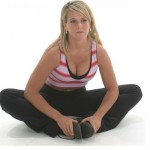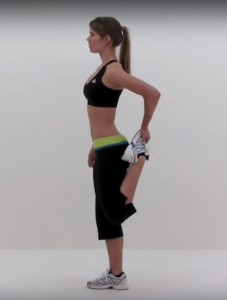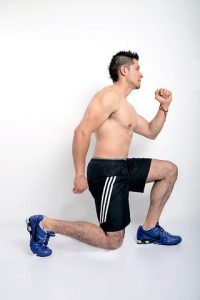Stretching before a workout can be helpful in preventing injury and enhancing performance, depending on the type of stretches you do. A study published in Sports Medicine found that dynamic stretching before a workout positively affected performance levels and the controlled movements even resulted in expanded range of motion. Static stretching, which is done simply by reaching to a point of tension then holding the stretch for a moment, will help with flexibility, but not much else. Static stretches are useful, though, when performed during your post-workout cool down because they’re an effective way to keep moving while bringing your heart rate down. Plus the improved flexibility will stay with you long-term to decrease chances of future injuries.
Walking Lunge Stretch–Dynamic
The lunging action in this movement will stretch most of your leg, affecting your quads, hamstrings, and calves. Make sure you have enough room to walk several long strides. Step out as far as is comfortably possible with your left foot, bending your left knee and keeping it just above the toes of your left foot. As you step, lower your right knee to just a few inches above the ground. Keep your upper body straight, abs tight. Rise up, bringing your right leg forward to take the lead in a long stride and bending it in the same way you did your left leg, this time lowering your left knee to just a few inches above the ground. Take at least 10 strides.
Butt Kicks—Dynamic
Butt Kicks will work on your quads and give you a little cardio warm-up while you do it. While jogging in place, bring your heels up to your glutes with each step. You’ll feel the stretch in your quadriceps with the exaggerated pull-back of the steps, and jogging in place will increase your heart-rate. This stretch can be performed a set number of times for the stretching benefits or for a per-determined amount of time to enhance the cardio aspect.
Inner/Outer Thigh Stretches—Dynamic
You might need a stabilizing object, such as a pole or even a chair for performing this stretch for your adductors and abductors. Standing straight and holding onto a chair with your right hand for support if you need it, lift your left leg out to the side. Swing the leg back down and across your body in one smooth motion. Keep your upper body straight, concentrating on moving nothing but your leg during this stretch. Continue moving the leg back and forth through the full range. Do several repetitions, at least 10, before switching sides and stretching your right leg.
Sprinters Stretch–Static
You might know this one as a hurdle stretch. Sit on the floor with your right leg bent behind you and your left leg extended straight in front of you. Lean back slowly. This part of the stretch will work on your quads. Hold the stretch, without bouncing, to the count to 10. Then lean all the way forward, reaching for your toe. This second part of the movement will stretch your calf and hamstring muscles. After completing both parts of this stretch, switch legs and repeat the stretching process on the other side, performing 2 to 3 times on each side.
Butterfly Stretch–Static
 You’ll really feel it in your inner thigh muscles when you perform a butterfly stretch. Start by sitting on the floor. Bend your legs, bringing the soles of your feet together. Pull your heels in toward your body. Hold your feet with your hands, lean forward, and press your elbows down on your legs. Hold the position steady without bouncing for 10 seconds, then relax the pressure on your legs. Repeat this one 4 to 5 times.
You’ll really feel it in your inner thigh muscles when you perform a butterfly stretch. Start by sitting on the floor. Bend your legs, bringing the soles of your feet together. Pull your heels in toward your body. Hold your feet with your hands, lean forward, and press your elbows down on your legs. Hold the position steady without bouncing for 10 seconds, then relax the pressure on your legs. Repeat this one 4 to 5 times.
Standing Quad Stretch–Static

Image via FitnessBlender/YouTube
The standing quad stretch is a useful one for runners and, as the name suggests, works on your quadriceps. Standing up straight, bend your left knee and catch your left foot with your right hand. Pull your left leg into your body, all the way to your glutes if you are flexible enough. Hold steady for a count of 10 before releasing your foot and moving to the other side to stretch your right leg. It may be necessary to do this one with a chair or other stabilizing object if you need help with balancing on one foot. Also, if you’re not limber enough to grab your foot with the opposite hand, you may have to start out by using your left hand with your left foot and your right hand with your right foot. Repeat this stretch 3 to 4 times with each leg.

